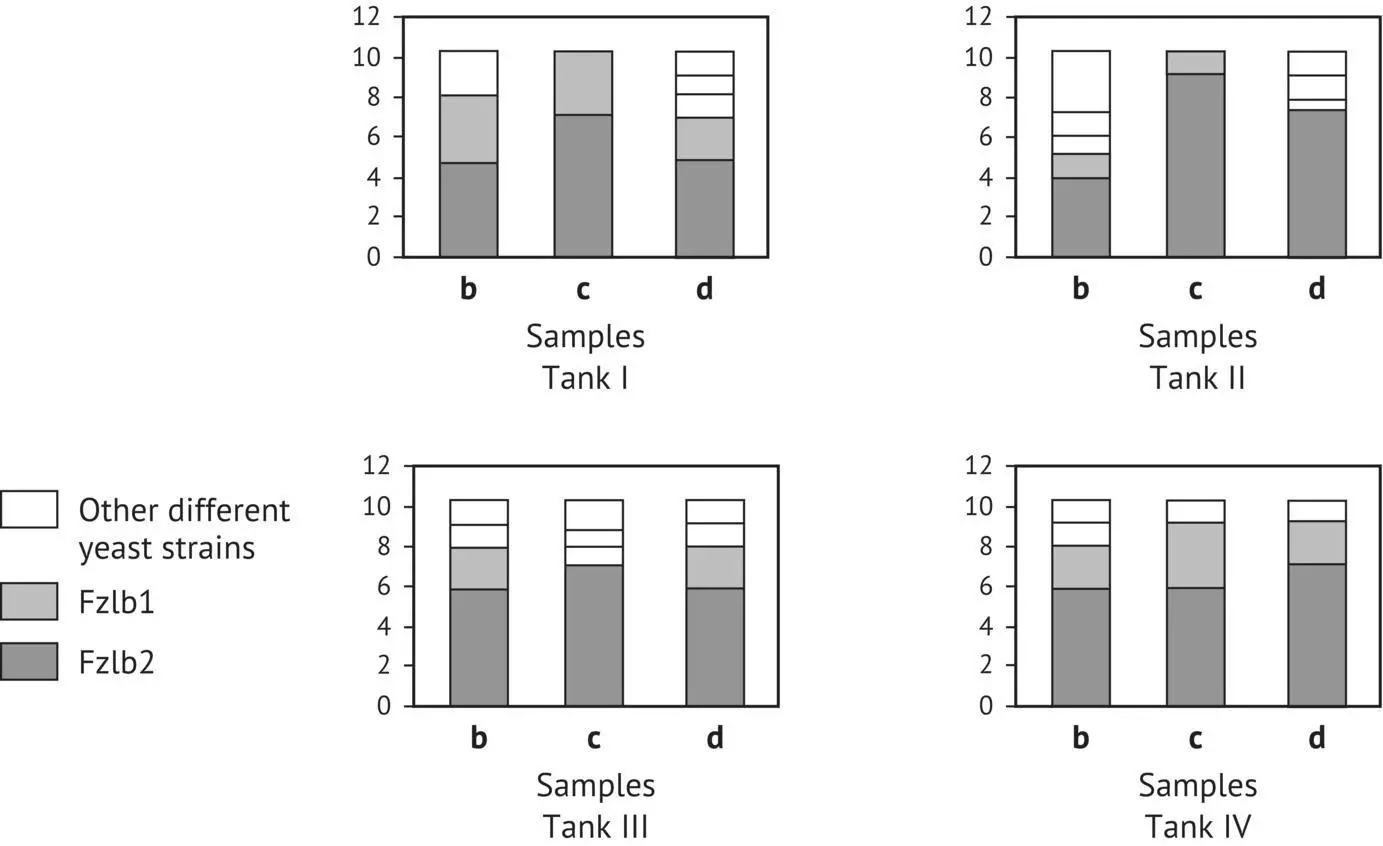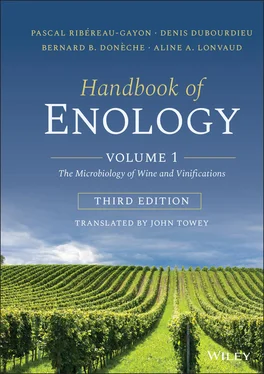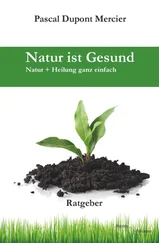1.10.2 The Ecology of S. cerevisiae Strains
The ecological study of the clonal diversity of yeasts, and in particular of S. cerevisiae during winemaking, was inconceivable for a long time because of a lack of means to distinguish yeast strains from one another. Such research has become possible with the development of molecular yeast strain identification methods ( Section 1.9). This section focuses on recent advances in this field.
The alcoholic fermentation of grape must or grapes is essentially carried out by a single yeast species, S. cerevisiae . Therefore, an understanding of the clonal diversity within this species is much more important for the winemaker than investigations on the partially or non‐fermentative grape microflora.
The analysis of S. cerevisiae strains under practical winemaking conditions in particular is intended to answer the following questions:
Is spontaneous fermentation carried out by a dominant strain, a small number or a very large number of strains?
Can the existence of a succession of strains during alcoholic fermentation be proven? If so, what is their origin: grapes, harvest equipment, or winery equipment?
During winemaking and from one year to another in the same winery or even the same vineyard, is spontaneous alcoholic fermentation carried out by the same strains?
Can the practice of inoculating with selected strains modify the wild microflora of a vineyard?
During recent research conducted in the Bordeaux region (Dubourdieu and Frezier, 1990; Frezier, 1992; Masneuf, 1996), many samples of yeast microflora were taken in the vineyard and the winery from batches of white and red wines spontaneously fermenting or inoculated with ADYs. Several conclusions can be drawn from this research, carried out on several thousand wild strains of S. cerevisiae .
In the majority of cases, a small number of major strains (one to three) representing up to 70–80% of the colonies isolated, carry out the spontaneous fermentations of red and dry white wines. These dominant strains are found in comparable proportions in all of the fermentation tanks from the same winery from the start to end of alcoholic fermentation. This phenomenon is illustrated by the example given in Figure 1.37, describing the native microflora of several tanks of red must from a Pessac‐Léognan vineyard in 1989. The strains of S. cerevisiae , possessing different karyotypes, are identified by an alphanumeric code comprising the initial of the vineyard, the tank number, the time of the sampling, the isolated colony number, and the year of the sample. Two strains, Fzlb1 (1989) and Fzlb2 (1989), are encountered in all of the tanks throughout the entire alcoholic fermentation process.
The spontaneous fermentation of dry white wines from the same vineyard is also carried out by the same dominant yeast strains in all of the barrels.

FIGURE 1.37 Breakdown of S. cerevisiae karyotypes during alcoholic fermentation in red grape tanks in the Fz vineyard (Pessac‐Léognan, France) in 1989 (Frezier, 1992). b, c, and d designate the start, middle, and end of alcoholic fermentation, respectively. Tanks I and II (Merlot) and III and IV (Cabernet Sauvignon) were filled on the 1st, 3rd, 17th, and 23rd day of the harvest, respectively.
The tank filling order and the grape variety have little effect on the clonal composition of the populations of S. cerevisiae spontaneously found in the winery. The daily practice of pumping over the red grape must, with pumping equipment used for all of the tanks, and the contact of must with the atmosphere in the cellar enriched with S. cerevisiae populations probably ensure the dissemination of the same strains in the winery. In white winemaking, the wine press facility plays the same role as an inoculator.
The same major strain is frequently encountered for several consecutive vintages in the same vineyard in spontaneously fermenting red must tanks. In 1990, one of the major strains was the same as the previous year in the red must tanks of the Fz vineyard. Other strains appeared, however, which had not been isolated in 1989.
When sterile grape samples are taken, pressed sterilely, sulfited at winemaking levels, and fermented in the laboratory in sterile containers, one or several dominant strains responsible for spontaneous fermentations in the winery exist in some samples. These strains are therefore present in the vineyard. In practice, they probably begin to multiply as soon as the grapes arrive at the winery. A few days into the harvest, they infest the winery equipment, which in turn ensures a systematic inoculation of the fresh grape crop.
The presence each year of the same dominant strain in the vineyard is not systematic ( Table 1.8). In the Fz vineyard, the Fzlb2‐89 strain could not be isolated in 1991, although it was present in certain vineyard samples in 1990, 1992, and 1994. In 1993, another strain proved to be dominant in spontaneous fermentations of sterile grape samples.
The spontaneous microflora of S. cerevisiae seems to fluctuate. At present, the factors involved in this fluctuation have not been identified. In a given vineyard, spontaneous fermentation is not systematically carried out by the same strains each year, and there is thus no specific strain that is one of the vineyard's characteristics. Ecological observations do not confirm the notion of a vineyard‐specific yeast. Furthermore, some native strains, dominant in a given vineyard, have been found in other nearby or distant vineyards. For example, the Fzlb2‐89 strain, isolated for the first time in a vineyard in Pessac‐Léognan, was later identified not only in the spontaneous fermentation of dry white and red wines of other vineyards in the same appellation but also in relatively distant wineries as far away as the Médoc. This strain has since been selected and commercialized under the name Zymaflore F10.
TABLE 1.8 Rate of Occurrence of the Dominant Fzlb2‐89 Karyotype in Microvinifications Carried Out on Sterile Grape Samples (I, II, and III) in the Fz Vineyard (The Number of Clones Analyzed is Indicated in Parentheses)
|
1990 (30 clones) |
1991 (60 clones) |
1992 (85 clones) |
1993 (74 clones) |
1994 (79 clones) |
| Sample 1 |
— |
— |
25% |
— |
87% |
| Sample 2 |
70% |
— |
31% |
— |
— |
| Sample 3 |
— |
— |
3% |
— |
40% |
In some cases ( Figure 1.38), S. cerevisiae populations with a large clonal diversity carry out spontaneous must fermentation. Many strains coexist. Their proportions differ from the start to the end of fermentation and from one tank to another. Is it more favorable for the sensory characteristics of wine to have a fermentation with low or large clonal diversity? Few scientific works have addressed this question until now. Howell et al . (2006) showed that analytical profiles of wines obtained from mixed fermentations are different from those obtained with yeast monocultures. These cannot be reproduced by blending different monoculture wines. Evidently, metabolic interactions explain the differences observed between mixed fermentation and blending of monocultures. The contribution of a yeast clone to the aroma profile of a wine resulting from polyclonal fermentation cannot simply be predicted by this clone's population. Thus, the direct relationship between the diversity of yeast strains and wine complexity has not received until now any scientific demonstration and must be considered with care. In the Bordeaux region, the coexistence of a large number of yeast strains is often associated with slow fermentations, and sometimes even stuck fermentations before full depletion of sugars. No single strain seems to be capable of asserting itself. On the other hand, the presence of a small number of dominant strains generally characterizes complete and rapid spontaneous fermentations. These dominant strains are found from the start to the end of fermentation.
Читать дальше













